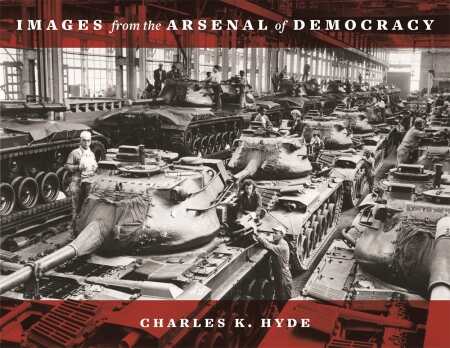Images from the Arsenal of Democracy
This companion book to American involvement in WWII exhibits photos that depict manufacturing to create a fascinating historical record.
As large as the attack on Pearl Harbor looms in the story of American involvement in World War II, it’s crucial to remember that America’s role began well before the country actually declared war. With Images From the Arsenal of Democracy, Charles K. Hyde has compiled a visual artifact of that crucial aspect of the war: the mobilization of American industry to manufacture weapons and vehicles for the Allies.
The images Hyde curated for this book originate from a dozen important sources, including the collections of the National Automotive History Collection, the Franklin D. Roosevelt Presidential Library, and the General Motors Corporation Media Archives. That diversity means the book includes shots of officials like President Roosevelt and William S. Knudsen (the General Motors president placed in charge of the National Defense Advisory Commission), as well as photos of assembly-line workers and the machines they built. The quality and framing of the images is sometimes unspectacular, but that’s to be expected, given their age and original purpose; the importance of these photographs lies in their use as historical record.
Some of the most interesting pictures show the way wartime manufacturing became a proud cause in industrial cities. These include local beauty queens posing with antiaircraft guns at the 1940 Chicago Auto Show, a large group of Packard plant workers in Detroit celebrating awards from the War Production Board, and workers at a Cleveland plant posing with the thousandth B-29 part they produced.
Photos (female machinists working at a Chrysler plant in Evansville, Indiana; a team riveting an airplane part while dressed in what would soon become the iconic “Rosie the Riveter” style) also give evidence of how valuable the integration of women into the blue-collar workforce was for the eventual war victory.
Hyde primarily tells the story through captions, which do a nice job of detailing where each image was taken and what the workers depicted were building, but the bigger picture is explained through only a few short essays. This makes Images From the Arsenal of Democracy more of a companion piece (Arsenal of Democracy, also by Hyde) for readers interested in the history depicted, yet it’s a worthwhile tribute to an often-overlooked aspect of the past century’s seminal event.
Reviewed by
Jeff Fleischer
Disclosure: This article is not an endorsement, but a review. The publisher of this book provided free copies of the book to have their book reviewed by a professional reviewer. No fee was paid by the publisher for this review. Foreword Reviews only recommends books that we love. Foreword Magazine, Inc. is disclosing this in accordance with the Federal Trade Commission’s 16 CFR, Part 255.

